As humans, we aren’t new to battles, even more so when it comes to battling micro-organisms. Time and again, there is an outbreak of some deadly viruses that have shaken humanity. To let you be aware, here is a list of the Top 10 worst health viruses of all time. To know more about it, let’s get into the details.
So what’s this noise about the virus? Simply put, a virus is a small infectious agent that is enclosed in a protein coat. It is made up of either DNA or RNA as its genetic material. Viruses are dangerous because they invade and multiply in a living host thereby causing a viral disease. In recent times, these microscopic organisms have been the cause of some of the most dangerous virus diseases in the world and have claimed countless lives.
As this piece is written, the world is grappling with the spread of COVID-19. We are aware of how deadly these pandemics can be and how big a threat they are to all of mankind. No matter the virus, we have been able to find a way out of each pandemic. Thanks to the advent of antiviral drugs and vaccines, we have the answers for a few of the worst health viruses and have been successful in curtailing the spread and severity of its impact. However, in today’s day and age, knowledge is power. If you know what you are dealing with, it helps to find a solution at the earliest possible. To help, here it is… the list of top ten dangerous viruses in the world that shook us in the past and now.
The List of Top 10 Most Dangerous Viruses in the World
Influenza Virus

Pic Courtesy: Shutter StockBelonging to the family Orthomyxoviridae, these RNA viruses are categorized into 4 types namely Influenzavirus A, B, C, and D. These deadly viruses are transmitted to other species that leads to devastating pandemic outbreaks. The various serotypes of Influenzavirus A caused Spanish Flu in 1918, Asian Flu in 1957, Hong Kong Flu in 1968, and Swine Flu in 2009. It is well known for being right up there with the top ten viruses of all time.
Case Fatality Rate: 2.5-5% (Appx)
Transmission: Airborne route through inhalation of the infected aerosols, direct transmission by way of an infected person, from contaminated surfaces and by hand to nose or mouth transmission.
Incubation Period: 1 to 4 days
Symptoms: Sore throat, high fever and chills, nasal congestion, runny nose, muscle pain, fatigue, petechial rash, shortness of breath, signs of dehydration, vomiting, and diarrhoea.
Treatment and prevention: The World Health Organization recommends an Influenza vaccine for high-risk groups. However, the high mutation rate of the virus makes it difficult to offer complete protection. Antiviral medications can prevent the replication of the virus. Non-pharmaceutical interventions such as maintaining good personal hygiene, self-isolation, surface disinfection, and avoiding contact with infected people does help in the control of this deadly viral outbreak.
Ebola Virus

Pic Courtesy: ABC NewsThese single-stranded RNA viruses are filamentous in nature. This too easily fits into the list of the 10 most dangerous viruses in the world. It causes the fatal Ebola Virus Disease which was once known as Ebola hemorrhagic fever. It is transmitted to humans through non-human primates, fruit bats, and porcupines. The first Ebola outbreak occurred in the year 1976 in Sudan and Zaire. However, the Ebola epidemic in West Africa from 2014 to 2016 that moved across borders was the most complex and the largest so far with 11,315 reported deaths.
Case Fatality Rate: 50% (Appx)
Transmission: The disease spreads through direct contact. Infected body fluids, blood, mucus, saliva, faeces, vomit, urine, and semen can transmit the disease.
Incubation period: 2 to 21 days.
Symptoms: The symptoms range from fatigue, fever, muscle pain, sore throat, and headache. It progresses to diarrhoea, vomiting, rashes, impaired liver and kidney functions, and external bleeding in gums and stool.
Treatment and prevention:
While there is no proven remedy for Ebola, but a range of immune therapies, blood products, vaccines and drugs are being evaluated currently. However, simple interventions such as using oral rehydration solution and treating specific symptoms like diarrhoea, vomiting, blood pressure can help. Regular handwashing with soap and avoiding direct contact with infected people can help prevent the spread of the disease.
SARS Coronavirus
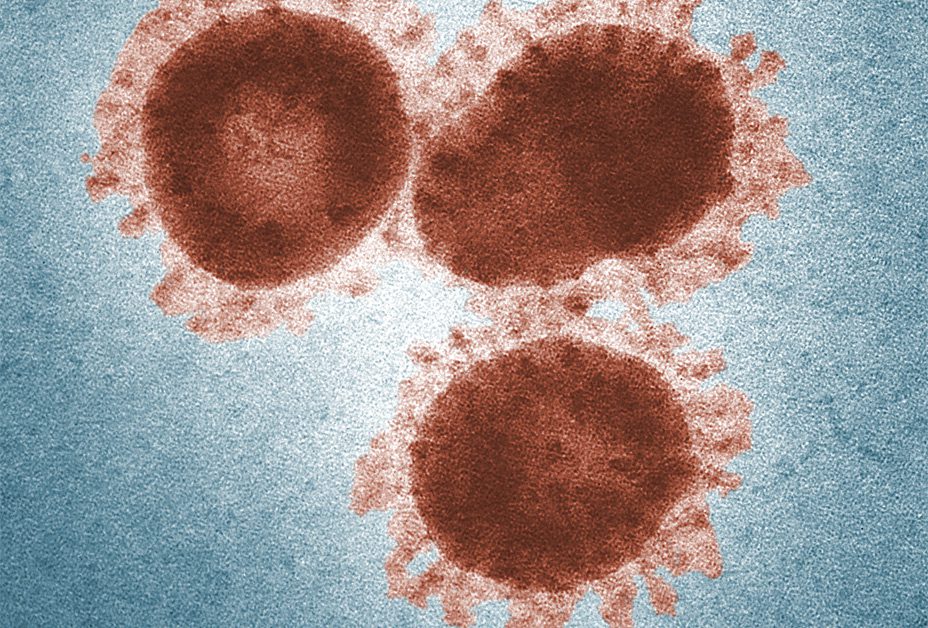
Pic Courtesy: Centers for Disease Control and PreventionSevere Acute Respiratory Syndrome Coronavirus (SARS–CoV) is a single-stranded, enveloped RNA virus belonging to the genus Betacoronavirus. Being one among the top ten worst health viruses, it causes severe respiratory illness in humans. It caused a devastating outbreak during 2002- 2004 in Guangdong, China, and Foshan. Bats and palm civets are known to be the reservoirs of SARS-related coronaviruses.
Case Fatality Rate: 11% (Appx)
Transmission: The disease is transmitted through direct contact of respiratory secretions and faeces. Animal to human transmissions too were reported and transmissions through infected droplets in the air made it even more dangerous.
Incubation period: 2 to 7 days
Symptoms: High fever associated with chills, malaise, headache, myalgia, shivering, shortness of breath and diarrhoea are noticed. Some also develop a nonproductive dry cough and pneumonia.
Treatment and prevention:
While there are no drugs or vaccines to treat, patients require supportive care through oxygen therapy and mechanical ventilation. Airway management and tracheal intubation are also administered as part of life support systems. Avoiding close contact with infected individuals, frequent hand washing, wearing a mask, and social isolation have proven effective to control the spread of the infection.
MERS Coronavirus

Pic Courtesy: Intelligent LivingMiddle East Respiratory Syndrome Coronavirus (MERS-CoV) also belongs to the genus Betacoronavirus. Similar to SARS, the infecting virus is made of single-stranded RNA. It was first reported in 2012. By 2015, it was spread to 27 countries in South Asia, the Middle East, and Africa. Humans were infected from camels making it a zoonotic transmission. It is also known as camel flu.
Case Fatality Rate: 35% (Appx)
Transmission: The virus can be transmitted from animals such as bats and camels to humans. Human transmission of the MERS-CoV is limited to sharing the same house or things used by the infected. However, very close contact with severely ill patients can result in illness. There is no reported case of asymptomatic transmissions.
Incubation period: 1 to 5 days
Symptoms: Patients show mild to severe respiratory-related difficulties or remain asymptomatic. Cough, fever, shortness of breath, myalgia, and expectoration are typical symptoms of the disease. Diarrhoea, vomiting, abdominal pain and pneumonia have also been reported in some cases.
Treatment and Prevention: Specific treatment or vaccines are currently unavailable but are in R&D at the moment. Replacement of fluids, oxygen therapy, mechanical ventilation, and pain relievers are offered as supportive therapy. Practising hygiene while visiting farms, animal markets, barns are considered essential. Consumption of well-cooked animal products is recommended.
SARS CoV-2 Coronavirus (COVID-19)
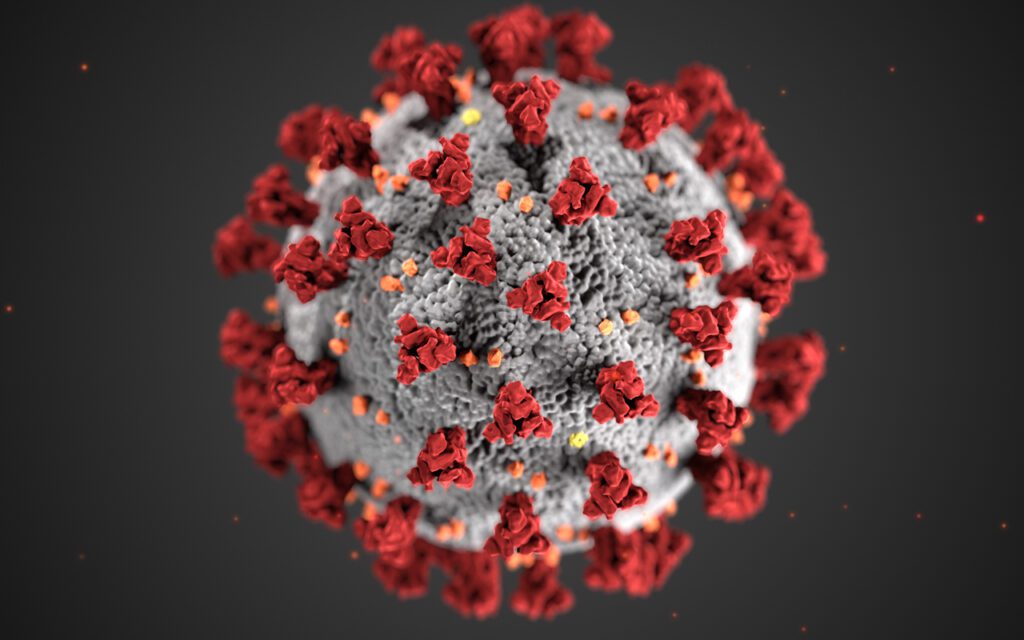
Pic Courtesy: Centers for Disease Control and PreventionThe ravaging COVID-19 strain is zoonotic and can be found in rodents and bats. They are enveloped, single-stranded RNA viruses belonging to four genera namely, Alphacoronavirus, Betacoronavirus, Deltacoronavirus, and Gammacoronavirus. SARS CoV-2 belongs to genus betacoronavirus that was first identified in Wuhan city, China during December, 2019. When you look at what health viruses are going around currently, this virus is making headlines every day. The number of coronaviruses cases are constantly on the rise across the globe. It is still an unsolved puzzle as to how the strain from rodents and bats mutated to impact humans.
Case Fatality Rate: 0.25-10% (the appx figures cannot be determined yet as the virus is still at large)
Transmission: COVID-19 Coronavirus is transmitted through both direct and indirect contact. Contact with infected people, their respiratory secretions, saliva, and secretion droplets can transfer the virus. Contaminated surfaces and objects pave way for indirect transmission.
Incubation Period: 5 to 6 days but sometimes can even take up to 14 days
Symptoms: Many suffer from mild to moderate illness. However, the elderly and others with co-morbidities develop serious complications. Fever, tiredness, dry cough, body ache, shortness of breath, sore throat, loss of taste and smell, pneumonia, and skin rash are reported some common symptoms. Some cases are asymptomatic as well.
Treatment and Prevention: Several ongoing clinical trials are evaluating a potential cure for this deadly pandemic. Oxygen therapy and mechanical ventilation are administered for those with severe symptoms. Washing hands regularly with soap, maintaining 1-metre distance while interacting with someone, wearing a mask, social isolation, and practising good personal hygiene are some of the key takeaways to curtail the spread.
Dengue Virus
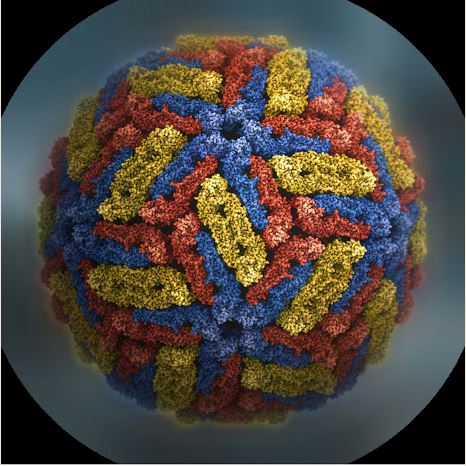
Pic Courtesy: Virus WorldDengue virus (DENV) is a single-stranded RNA virus belonging to the flavivirus genus. There are five serotypes of this virus and it is becoming one of the dreaded mosquito-borne human pathogens. It has a worldwide prevalence, especially in tropical and subtropical countries. 40 million cases of dengue fever and dengue hemorrhagic fever were reported in the late ’90s. The virus has now spread to new regions and outbreaks occur every four to six months.
Case Fatality Rate: 1-20% (depending on the disease progression)
Transmission: The bites of infected female mosquitoes Aedes aegypti transmits the virus to humans. The mosquitoes remain closer to human habitation. The daytime feeder mosquitoes are active early in the morning and before dusk. However, in the case of dengue, there is no human transmission.
Incubation period: 3 to 14 days
Symptoms: Fever accompanied by headache, muscle ache, joint and bone pain, rashes and minor hemorrhagic manifestations. Vomiting and nausea are also reported.
Treatment and Prevention: Analgesics and supportive therapies such as fluid replacement is considered. A vaccine for dengue has been licensed and it’s used in about 20 countries. However, prevention is the best way to keep away from the risk of dengue infection. Clearing the stagnant water away, use of mosquito repellants, covering the water storage tanks can help prevent the disease.
Human Immunodeficiency Virus
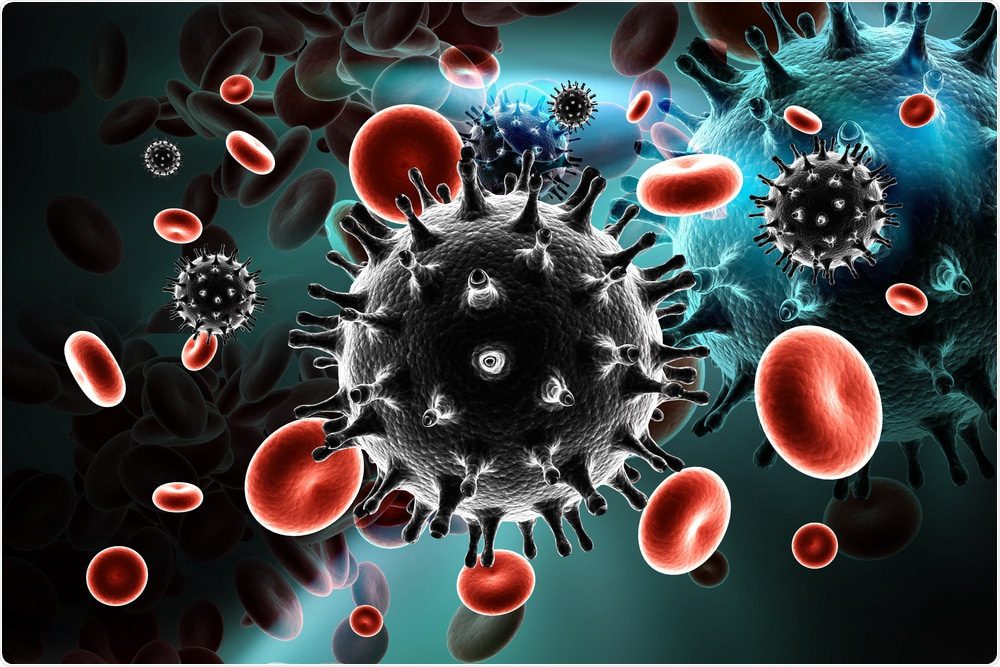
Pic Courtesy: News-Medical.NetIt is a retrovirus that belongs to the lentivirus genus. It infects the human immune system and causes Acquired Immune Deficiency Syndrome (AIDS). The virus first originated in the Congo region around 1920 and was spread from chimpanzees to humans. Several cases of AIDS were reported during the 1980s and 1990s and it was declared the leading cause of death among adults. This prominent health virus from the 90s had created a global pandemic emergency.
Case Fatality Rate: Almost 100% (if left untreated)
Transmission: The virus is spread through sexual contact, exposure to infected fluids, sharing needles, as well as from an infected mother to the baby during pregnancy, delivery or breastfeeding.
Incubation period: 1 to 4 weeks
Symptoms: In the initial period, fever, enlargement of lymph nodes, rashes, headache, tiredness, vomiting, and diarrhoea are reported. While the disease can last up to 20 years, progressive weight loss, muscle pain, tuberculosis, pneumonia, and other opportunistic infections are seen.
Treatment and Prevention:
While there is no vaccine for HIV, the treatment comprises of antiretroviral therapy. It slows the progression of the disease and focusses on the prevention and treatment of opportunistic infections. Use of condoms, limiting the number of sexual partners, using sterile needles and syringes, and avoiding drugs help prevent AIDS.
Nipah Virus
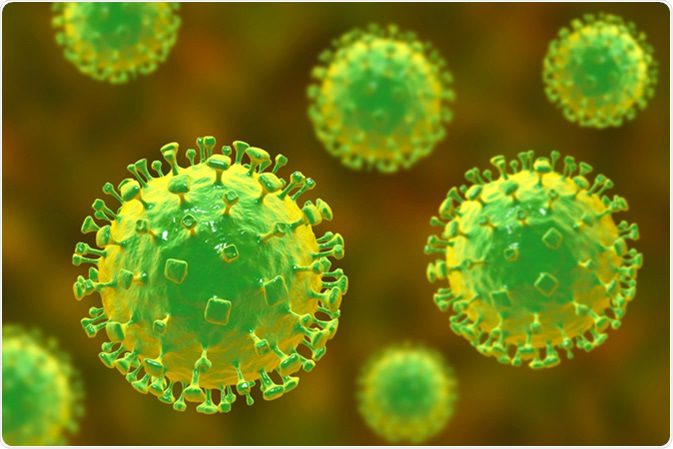
Pic Courtesy: News-Medical.NetIt is a bat-borne zoonotic virus that belongs to the Henipavirus genus. Nipah virus outbreaks have been reported from the 1990s in Singapore, Bangladesh, Malaysia, and India. It is one among the most deadly virus in India as Nipah virus infects a wide variety of animals and can be fatal to humans. The outbreak of Nipah virus encephalitis in Kerala, India had risked several lives.
Case Fatality Rate: 40-75%
Transmission: The virus is spread through direct contact with infected animals and their tissues. Consumption of fruits contaminated by infected fruit bats and human transmission has also been recorded.
Incubation period: 4 to 14 days
Symptoms: It can range from asymptomatic to acute and severe respiratory infection. Fever, headache, sore throat, vomiting, myalgia, altered consciousness, pneumonia, respiratory distress, encephalitis, seizures, and coma have been reported.
Treatment and Prevention: No vaccines or drugs have been currently developed for Nipah virus encephalitis. Respiratory and neurological complications are handled through intensive supportive care. Avoiding fruits with signs of bat bites, keeping bats away from food processing sites, hygienic practices in slaughtering operations, avoiding contact with infected people helps to prevent it.
Rabies Lyssavirus

Pic Courtesy: MicrobeWikiIt is an enveloped neurotropic virus with single-stranded RNA belonging to the Lyssavirus genus. The rabies virus affects humans through animal bites. It is a prevalent disease in more than 150 countries where domestic dogs are the common reservoirs of the virus. 95% of rabies cases are reported in Africa and Asia.
Case Fatality Rate: Almost 100% (once clinical symptoms are seen)
Transmission: The saliva of rabies-infected animals transmits the virus to humans through a bite or scratch. Transmission also happens via the saliva of infected animals coming into direct contact with the mucosal layer of humans. There is no reported confirmation of human transmission though.
Incubation period: 2 to 3 months
Symptoms: Fever accompanied by pain, unusual pricking, tingling or burning sensation at the site of the wound, progressive inflammation of the brain, excitable behaviour, hydrophobia, paralysis of muscles, coma and eventually death occurs.
Treatment and Prevention: Rabies vaccine is 100% effective if given within ten days of the bite. Vaccinating dogs prevents dog-mediated rabies. Proper education on pet behaviours, immediate care measures and immediate immunization after a dog bite can help prevent rabies.
Poliovirus
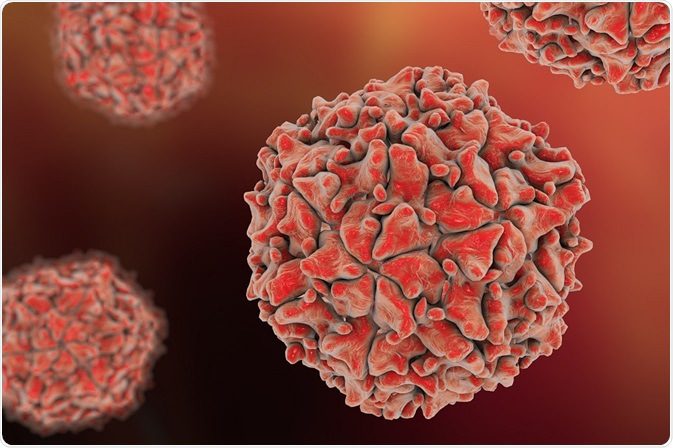
Pic Courtesy: News-Medical.NetThe poliovirus enclosed in a protein capsid is made of a single-stranded RNA belonging to the enterovirus genus. It causes poliomyelitis or polio which is a life-threatening and disabling disease. Frequent epidemics of polio raised during the 1940s and 1950s across the world. It affected children severely and the need for a vaccine was strongly necessitated.
Case Fatality Rate: 5-10% (in case of irreversible paralysis)
Transmission: A highly contagious disease that is transmitted through the faecal-oral route and oral-oral route.
Incubation period: 6 to 20 days
Symptoms: Fever, sore throat, nausea, vomiting, abdominal pain, and headache occur during the first few days of infection. Muscle weakness, meningitis, and paralysis are also reported later. Finally, it leads to seizures and encephalitis.
Treatment and Prevention: Polio treatment focuses on preventing complications, promoting speedy recovery, and long-term rehabilitation. Corrective shoes, physiotherapy, nerve grafting, and orthopaedic surgery are adjuncts in the treatment. Today, polio is completely eradicated in most countries with passive immunization program and oral polio drops.
Though the given list of top 10 worst health viruses of all time can be a little scary, there is a lot of takeaways for mankind. Some simple changes like following a disciplined lifestyle, and paying attention to overall hygiene can go a long way in preventing any infection or disease. We have been successful in fighting several viral wars and vaccines have saved innumerable lives. Taking a few simple precautions, following health protocols and adhering to the directives laid by the World Health Organization can help one and all.

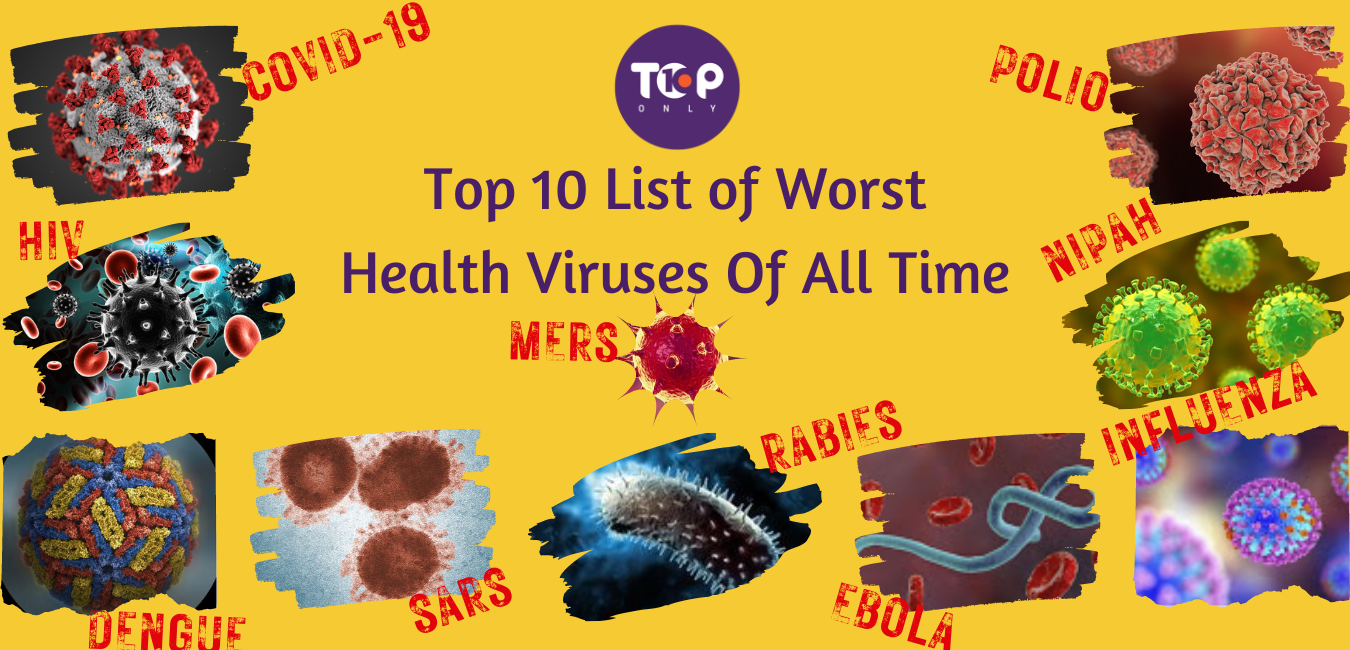
Interesting articles! I remember all of the outbreaks you’ve mentioned that occurred in the ’00s and beyond. My Grandad actually had Polio when he was a child and became severely malnourished – he was the only person on the ward that survived.
I’m glad your grand dad made it. As we have vaccines today, not many actually know how much impact virus infections like polio & rabies can have on mankind.
Excellent write up we’re even a non medical person can understand.
Thanks Ajoy!
Great post! This was super informative and very interesting to read.
Thanks JoJo!
Detailed information given about the scary viruses! We can hope for a better tomorrow, with proper safety measures taken today.
Thanks Lakshmi.
Very well explained about the viruses and it’s impact on humans and the availability of vaccines. Super Ramya. We can expect some more information like this from you in other subjects also. Well done ?
Thank you so much!
Kinda sad how history keeps repeating itself but also comforting in a way – the world went through these horrible things before, and went back to normal and so would we.
True that Madi.
Very informative and nicely presented.
Thank you
What a great and timely post? You have made an excellent comparison of the ‘TOP 10’ dangerous viruses. Thanks for another impressive and enlightening writing from you! Your content gives the glimpses of various types of harmful viruses, and your inputs are pretty useful for the readers in these challenging times.
Your description of COVID 19 brings some relief as the fatality rate of coronavirus is much less than HIV and Rabies. However, it has evoked a widespread fear due to its global infection at the same time.
Besides high-quality writing, your brilliant analysis of the viruses such as species name, fatality rate, incubation period and place of origin needs special appreciation. Excellent work !
Thank you for your nice words and encouragement.
Ramya,
It is sad that we are still dealing with Polio in the year 2020!
This reality check on worst health viruses of all time remind us that ‘we can beat Coronavirus too!’
It looks like Coronavirus came to teach us some things that we had taken for granted. Imagine the whole world staying at home, washing hands – over and over again-. contact tracing, travel checks, … we have completely altered our lives.
Love the stats on the other viruses!
i shared the post.
H Emma || https://thextraordinarionly.com
Thanks Emma for the appreciation & share. True that COVID has given us a reality check. Only solace is that it’s not the most dangerous even though it seems far more contagious than most.
Pingback:Top 10 List | Side Hustles Relevant Today | Top 10s Only
Pingback:Top 10 Best Brother-Sister Movies in Bollywood | Top 10s Only
Pingback:Top 10 Best Movies of Kamal Haasan In Multiple Roles | Top 10s Only
Pingback:The Significance Of World AIDS Day | Top 10s Only
Pingback:Top 10 Business Ideas From 5 Lakhs to 10 Lakhs| Top 10s Only
Pingback:Top 10 Best Movies of South Indian Actor Vikram | Top 10s Only